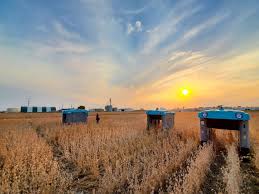Source: theburnin.com
Farming isn’t usually considered a high-tech sector. That’s been changing in recent years thanks to new innovations in areas like artificial intelligence (AI) and robotics. Farmers who adopt high-tech solutions are often able to increase yield, cut costs, and produce healthier food.
Perhaps that is why Alphabet’s X lab, the division responsible for launching Waymo, is eyeing farming as its next target area. The company recently revealed its latest “moonshot” project. Dubbed Mineral, it focuses on a robot that inspects crops and a platform designed to analyze that data.
The combined approach introduces the concept of “big data” to the world of farming and could have profound implications.
Working the Problem
The agriculture industry has a massive challenge ahead of it. Experts predict that global hunger problems will only continue growing as the Earth’s population expands over the next decade. Mineral’s website says, “To feed the planet’s growing population, global agriculture will need to produce more food in the next 50 years than in the previous 10,000—at a time when climate change is making our crops less productive.”
Obviously, the situation is less-than-ideal. It’s clear that traditional farming approaches won’t be enough to solve this dilemma. Fortunately, technology might be able to help.
A major part of Mineral’s plan revolves around a four-wheeled robotic prototype that somewhat resembles a moon rover. The team appropriately calls it a plant buggy. It can study crops, soil, and other characteristics of the environment over a large area thanks to a suite of cameras and sensors. Those findings are then compared with satellite photos and weather data, according to Nick Statt of The Verge.
Using that wealth of information, scientists are able to predict how plants will grow by using AI models. So far, the Mineral team is testing the approach with soybean crops in Illinois and strawberry fields in California.
The company says, “Over the past few years, the plant buggy has trundled through strawberry fields in California and soybean fields in Illinois, gathering high quality images of each plant and counting and classifying every berry and every bean. To date, the team has analyzed a range of crops like melons, berries, lettuce, oilseeds, oats and barley—from sprout to harvest.”
Data-Driven Farming
It’s clear that Mineral’s approach has real-world implications that are important for humanity’s fight against hunger. The idea of using tech to optimize plant growth isn’t something that Mineral is alone in pursing.
A number of other startups are exploring the same space. Some are even turning to alternative approaches like hydroponics and vertical agriculture to further enhance the effects of data-driven farming.
In the days to come, Mineral will continue to partner with farmers around the world to improve its system and adapt it to meet the unique needs of various agriculture segments.
Project lead Elliott Grant says, “Just as the microscope led to a transformation in how diseases are detected and managed, we hope that better tools will enable the agriculture industry to transform how food is grown.”
